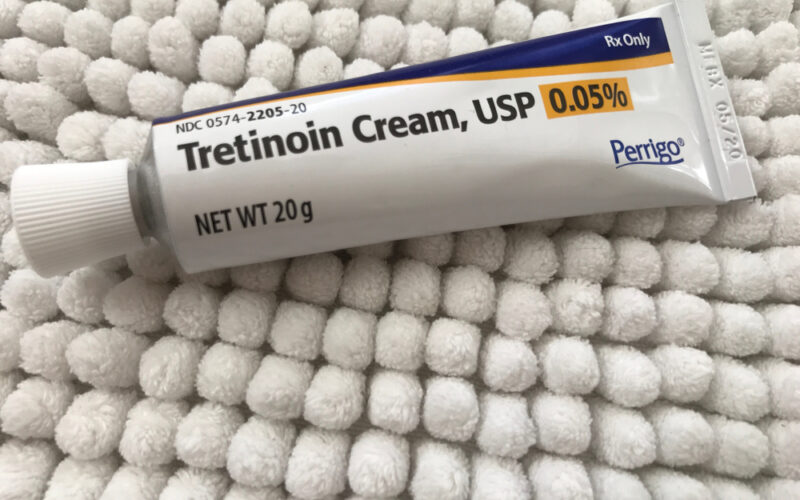If you’re exploring anti-aging and acne-fighting skincare, you’ve likely encountered both tretinoin and retinol. Though they belong to the same family, these ingredients differ significantly in strength and accessibility. Understanding the difference between tretinoin and retinol will help you choose which best suits your skincare needs.
Understanding the Retinoid Family
Retinoids are vitamin A derivatives that accelerate cell turnover, boost collagen, and improve skin texture. Within this family, several compounds exist at varying potency levels. Retinol is an over-the-counter retinoid that converts to retinaldehyde, then to retinoic acid (the active form) in your skin. This multi-step process makes retinol gentler but less potent than prescription options. Tretinoin (also known as retinoic acid or Retin-A) is a prescription-strength retinoid already in its active form, allowing it to work directly on skin receptors. This direct action explains why tretinoin potency significantly exceeds over-the-counter options in any retinoid comparison.
What Makes Tretinoin More Potent Than Retinol?
The primary difference between tretinoin and retinol comes down to bioavailability. Tretinoin is already in its active form (retinoic acid), so it immediately binds to skin receptors upon application. In contrast, retinol requires a two-step conversion process, during which much potential potency is lost. Studies suggest retinol may be 10-20 times less potent than tretinoin due to these conversion steps. This difference in retinol strength versus tretinoin potency explains why results with retinol typically take longer to appear. Tretinoin also has decades of clinical research supporting its efficacy for acne, photoaging, and hyperpigmentation, making it the gold standard in any retinoid comparison.
Pros and Cons of Using Retinol
Retinol offers several advantages: it’s available without a prescription at various price points, has a lower irritation risk making it suitable for sensitive skin, comes in various formulations (serums, creams, oils), has fewer application restrictions, and serves as an excellent gateway to stronger retinoids. However, it does have drawbacks: results take longer to appear, quality varies between brands, manufacturers aren’t required to list exact percentages, research is less extensive compared to prescription options, and it may not adequately address severe skin concerns. When comparing retinol vs prescription retinoids, retinol is ideal for beginners, sensitive skin types, or those seeking gradual improvements with minimal irritation.
Pros and Cons of Using Tretinoin
Tretinoin offers significant benefits: maximum efficacy for wrinkles, acne, and skin texture; faster results often appearing within weeks; consistent pharmaceutical-grade quality; decades of clinical studies supporting its effectiveness; and potential long-term cost efficiency. The downsides include: requiring a prescription, higher irritation risk causing redness and peeling, an uncomfortable adjustment period, increased sun sensitivity requiring diligent protection, and contraindication during pregnancy and breastfeeding. In the tretinoin vs retinol debate, tretinoin is ideal for those seeking dramatic results, battling persistent acne, addressing significant aging signs, or wanting the most evidence-backed option.
How to Decide Which One is Right for You
The choice between tretinoin vs retinol depends on several factors. Consider retinol if you’re new to retinoids and want to start gradually, have sensitive skin prone to irritation, prefer a no-prescription option, are pregnant or breastfeeding (consult your doctor first), or value convenience over maximum results. Consider tretinoin if you’ve built tolerance with over-the-counter retinoids, are addressing significant acne or photoaging, want the most effective research-backed option, can manage through an adjustment period, and have consulted with a healthcare provider. Your skincare goals, skin sensitivity, and patience level should guide your decision, with consistency mattering more than starting with the strongest option.
Transitioning from Retinol to Tretinoin
If you’ve been using retinol but want to graduate to tretinoin for more significant results, follow these steps for a smooth transition. First, consult a healthcare provider for personalized advice and an appropriate prescription strength. Reduce your retinol frequency to 1-2 times weekly for two weeks before stopping completely. Give your skin 5-7 days without any retinoids before starting tretinoin. Begin with once-weekly application, gradually increasing to 2-3 times weekly. Consider applying moisturizer before tretinoin to reduce irritation. Increase moisturization and be diligent about sun protection. Expect some irritation but give your skin 4-6 weeks to adjust. Each skin type responds differently – some adapt quickly, while others need months of gradual adjustment.
Final Thoughts: It’s Not Always About Strength
When comparing tretinoin vs retinol, remember that stronger isn’t always better. The best retinoid for you is one you’ll use consistently without excessive irritation. Some achieve excellent results with retinol simply because they can use it regularly without the barriers of irritation or prescriptions. Consider your skincare as a marathon, not a sprint—even retinol, used consistently over years, can deliver remarkable improvements. The most effective retinoid is ultimately the one that fits seamlessly into your routine and budget. If you’re uncertain which path is right for you, consulting with a healthcare provider can provide personalized guidance. At Heally, our dermatology professionals can help navigate the retinoid comparison process, providing prescriptions when appropriate and helping develop a sustainable routine. Schedule a consultation with Heally today to determine whether tretinoin or retinol is right for your skin.
Sources
Healthline: What’s the Difference Between Retinol and Tretinoin?
Book Free Consultation

